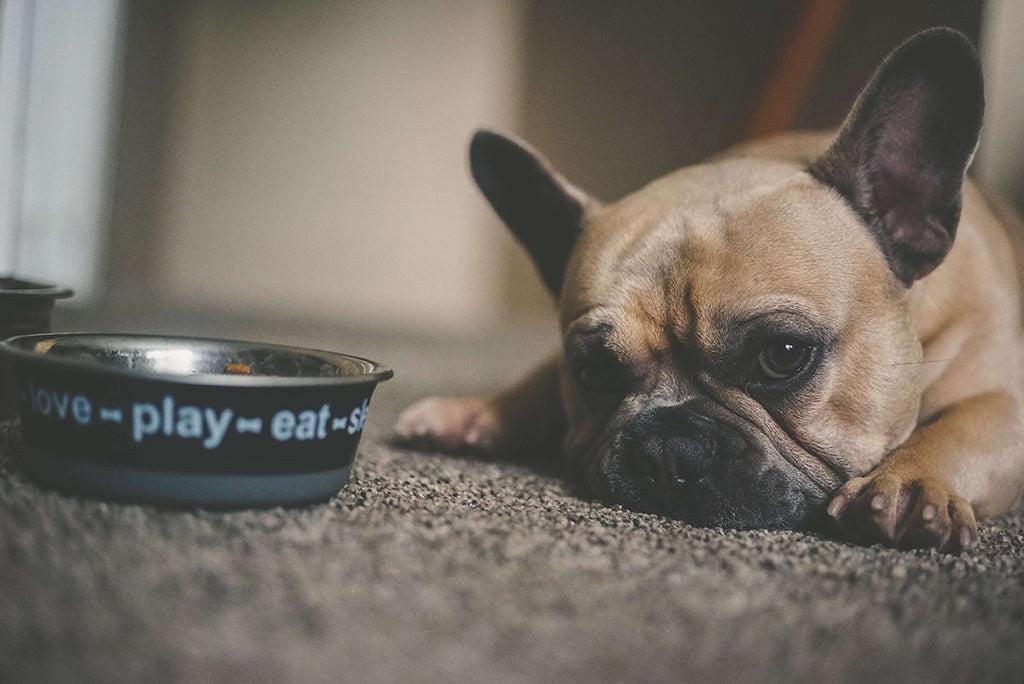In this blog, we ask “can dogs have eating disorders?”. We learn what different types of eating disorders in dogs there are and how to spot each type of disordered eating in dogs. Read on to learn more about dog eating disorders.
Dog Eating Disorders: Does Your Dog Have One?

Can Dogs Have Eating Disorders?
When we think of eating disorders, we automatically think about anorexia and bulimia but that’s only the surface of it. An eating disorder is an umbrella term for all sorts of disordered eating that doesn’t just stop at starvation or purging. These debilitating conditions can completely take over people’s lives and be life-threatening… But, did you know that dogs can develop eating disorders too?
Dog eating disorders can be brought on by a number of reasons and can affect all dog breeds of all ages. They’re more common than you think too! So, what different dog eating disorders are there and how do you identify them?
Dog Eating Disorders
Pica
Pica (pronounced Pie-Kuh) is a dog eating disorder that involves eating non-digestible items. This can be anything from rocks, human clothing, glass, coins to batteries, bark, wires, or gravel – it really could be anything! It’s worth noting that this is different from a teething puppy who may be chewing random items to relieve teething discomfort.
Pica is very serious. If an adolescent or adult dog is consuming non-digestible items, it can cause irreversible and life-threatening damage to their gums, teeth, and insides and end up in multiple expensive trips to the vet!
The causes of pica can be quite serious including brain lesions or pancreatic/circulation abnormalities. These urgently need to be ruled out, and if a physical issue isn’t present then the psychological reason (like severe stress or anxiety) needs to be identified with haste to stop the pica in its tracks.
Most vets agree that pica tends not to be brought on by a lack of nutrition or hunger.

Overeating
Overeating is a disorder that’s more easily controlled by a pet parent. Most doggies don’t eat because they’re hungry, they eat because they can! So, those puppy dog eyes after dinner aren’t happening because they aren’t full…
This is relatively normal canine behavior, so it’s up to you to restrict what’s available to them. If a dog becomes overweight through overeating, they are at a higher risk of joint issues and a number of serious health issues that can drastically impact their quality of life.
If you’re unsure how much food your dog should be having, chat to your vet, and don’t forget that treats are calories too so why not read our blog: How Many Treats Should You Feed Your Dog?
Under-Eating
Doggy anorexia – a refusal to eat or eating minimal amounts – can be one of the first signs of serious illness. Skipping the odd meal isn’t something to worry about, but missing out on consecutive meals over a period of days needs the attention of a vet as soon as possible. If a physical cause can’t be sourced, then they’ll want to address their stress and anxiety levels and work out why they emotionally may be refusing to eat.
It’s important you get this issue addressed by a qualified veterinarian quickly, as under-eating in dogs can be just as detrimental as overeating. It can leave them at risk of developing conditions like jaundice, organ shrinkage or failure, or abdomen distension. Causes of under-eating can be really diverse so it may take a lot of tests to source the underlying problem.
Scoffing
If your dog’s food vanishes before it’s even touched the sides of the bowl, and they act more like a vacuum than a dog when it comes to mealtimes, this is scoffing: another dog eating disorder.
Scoffing can be a habit that’s been brought over to adulthood from fighting for food against their siblings as puppies. It is also more common in dogs who share their home with other animals. But, that’s not to say dogs who are the only pet can’t and won’t experience scoffing too.
Not being fed enough or parasitic infection can also cause scoffing to occur. Your vet will be able to help you identify the issue and you can do your bit by making sure they’re being fed enough and away from animals they may perceive as competition.
You can also support breaking the habit by purchasing specially designed feeder bowls that prevent their ability to scoff up their food. If they eat kibble, you may also choose to try hand feeding them small amounts of their food at a time.

Coprophagia (Feces Eating)
A common eating disorder in dogs, but a pretty disgusting one! Eating poop (theirs or another animal’s) can leave them vulnerable to contracting worms and other unwanted bacteria that can make them ill or sick.
If your dog is eating poop, read our blog on Why Dogs Eat Poop here, and in the meantime make sure they’re receiving reliable and regular parasitic prevention treatment to protect their health.
Dog Eating Disorders: What Are The Causes?
A number of things can cause a dog to have or develop a disordered relationship with food. These include:
- Stress
- Anxiety
- Lack of exercise
- Lack of mental stimulation (boredom)
- Curiosity
- Depression (via abuse, neglect, grief, or separation anxiety)
- An underlying health condition (like diabetes, worms, hormonal issues, or cancer)
If you suspect your dog has an eating disorder, get them an appointment with their vet so you can sort the issue together quickly.
Sources
Author Clark, Mike “5 Eating Disorders That Can Affect Dogs” Dog Time https://dogtime.com/dog-health/dog-behavior/50905-eating-disorders-dogs
Puotinen, CJ “Does Your Dog Have An Eating Disorder?” Whole Dog Journal, Nov 03. 2006 https://www.whole-dog-journal.com/behavior/canine-eating-disorders/
 S
S



